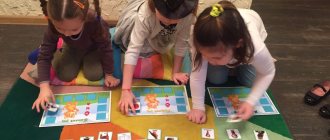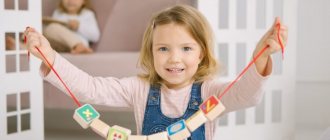December 9, 2021 All parents eagerly await their child's first word. At the same time, they understand that children cannot speak immediately after birth and that they need to be taught this. However, if a child does not pronounce the simplest words a year later, and even more so one and a half to two years after birth for an unknown reason, this is a reason to think about why this happens and how to teach a child to speak well. And to be even more precise, it is necessary to prepare a child for learning to speak in the very first months of his life.
Speech development up to 3 years
A child’s speech develops in certain stages, which are described in detail in various literature. Of course, within one period there may be deviations of plus or minus several months, but if the child begins to “lag behind” by one period or more, this is a reason to consult a doctor. And so that the opposite situation does not occur, when parents begin to sound the alarm ahead of time, it will be useful for them to know all these stages.
In the first months after birth, the child makes attempts to make the first “human” sounds, trying to repeat the speech of adults and responding to their calls to him. These sounds are the simplest (a, oh, i, u). And although they are easy to guess, the child pronounces them “through the nose” due to insufficient development of the speech apparatus. After a month and a half, the child begins to “walk” - adding several simple consonants to the above vowel sounds - g, k and x (this period is named after the most recognizable “word” - “gu”). An excellent sign of a child’s development is the fact that he begins to “walk” in the presence of adults, that is, he tries to establish contact with them in this way.
When children turn six months old, they begin to babble, that is, pronounce simple syllables and words: pa, ba, ma, etc. This period lasts up to 11 months or one year, and as the child grows, he masters more and more complex speech structures. By the end of the first year, he can form a simple sentence of 2-3 words and understands requests from his parents. If this does not happen, then you need to use methods to teach a child to talk at this age.
At the beginning of the second year of life, a normally developed child finally turns into a social being. He listens carefully to what adults tell him and tries to repeat adult speech. True, in most cases he speaks his own language, distorting many words and syllables, but they are understandable to his parents. This happens for about a year before reaching the third birthday. A healthy child is distinguished not by the ability to speak beautifully before his peers, but by regular progress in communication. Learning speech skills between one and two years is no less important than learning motor skills.
At 2-3 years old, children show the greatest progress in speech development. The child begins to speak in coherent sentences; More and more questions appear in his speech, with the help of which he studies the world around him. He begins to become aware of himself, his parents, relatives, friends and other people who meet in his life. If you don’t know how to teach a child to speak at this age (more precisely, to develop his speech skills), use the advice of experts. Read more books out loud, sing songs with your baby, and generally communicate as much as possible, replenishing his passive vocabulary. At this age, those skills that make humans different from animals become fully visible - the ability to think logically (and express one’s thoughts in words) and rationally explain one’s actions.
Benefits of Early Reading
Everyone knows that from an early age, children’s brains develop very actively. A particularly important period is the age of up to three years. This does not mean that after the age of three the baby learns worse, but it does mean that you can use the most favorable period when the baby grasps everything literally on the fly.
Let's look at a number of benefits that early reading gives a child.
- Learning to read at an early age is a good foundation for all subsequent development. This is a contribution to the intellectual potential that will serve the little man throughout his entire subsequent life. Children who actively strained their brains during the period of its growth and development are distinguished by a flexible and lively mind in adulthood, and no one can take this away from them.
- Early learning to read is an opportunity to spend quality time with parents in a fun and rewarding way.
- For a child, learning the alphabet and reading at an early age is a real discovery. Children are very curious and enjoy discovering new facets of this world. Therefore, the learning process itself will bring the child many interesting moments and satisfy the need for knowledge.
- Children who learn to read and count early grow more independent and self-confident, as they can keep themselves busy. Confidence is achieved due to the fact that the toddler realizes his potential and has success in the learning process, without putting much effort into it.
- At an early age, kids remember better - as mentioned above, they grasp all the information on the fly, so learning to read is faster and easier.
- In addition, early reading develops imagination, forming the right basis for creative potential, which will continue to develop at an active pace.
Basic exercises
Speech is an acquired human skill. It develops only after repeated repetitions, and repetitions, in turn, must be performed according to the pattern. This model is the speech of adults, which they try to copy - at first unsuccessfully, but then more and more successfully. This means that in order to develop speech, a child must develop the senses: vision, hearing and touch. It is not for nothing that it is recommended to surround a child with bright and beautiful toys and pictures from the first days of life so that he begins to form visual images.
But pictures alone are not enough to teach a child to speak. As in any other business, the basis here is practice. Parents should communicate with the baby as actively as possible, not monotonously, but emotionally. Don’t be afraid to repeat sounds after him, even if he pronounces them incorrectly - over time, he will remember these words and move on to learning new ones. Also, in the question of how to teach a child to speak, gymnastics for the arms, and especially for the hands and fingers, is very important. The connection between speech and fine motor skills has long been established, so after three months of life the baby can begin to massage his fingers. Then you can move on to educational games. At first these will be simple tasks (for example, getting an object out of a box), and as the child grows, you can move on to more complex tasks (sculpting, appliqué, etc.).
When the baby turns one year old, you need to switch to completely “human” communication. This means that parents should exclude gestures from their communication with children, and seek understanding from the child only with the help of words. It is useful to draw the child’s attention to the surrounding sounds and animal voices, making sure to comment on this to create images “attached” to these sounds. Also at this age, you should continue to communicate a lot with children, repeating individual words and expressions.
Teaching words
By the age of one year, a child's vocabulary is about 10 words. However, not all babies begin to speak at this age, so doctors allow a delay of several months. But if the child continues to babble for a long time, and words from these syllables do not form, it’s time to think about how to teach the child to speak words. This should not be done by doctors (they are approached only in extreme cases), but by the parents themselves. Moreover, this will not require much effort from them. The mother spends the most time with the baby, so she just needs to pronounce her every action. If you see that a child wants to ask a question or joins in the dialogue, support this initiative. There is nothing worse when children do not feel attention to themselves - because of this they become withdrawn, and their development is inhibited.
A good way to develop a child’s speech skills is a game in which parents themselves ask him questions by showing him an object or picture. The child must answer what it is - thereby developing his speech apparatus (he learns to correctly produce sounds) and areas of the brain responsible for memory and the formation of visual images. When you tell your baby a new word, you need to look directly at his face and pronounce the sounds loudly and clearly so that he gets used to the correct pronunciation. All objects and phenomena should be called by their proper names, without “adjusting” to the child and without simplifying concepts, even if they seem difficult to pronounce.
When teaching your child new subjects and phenomena, do not forget about verbs. Often parents name the concept itself (that is, they use a noun), but forget about the description of the actions. This is not entirely correct, since verbs are an integral part of speech. In order for a child to learn how to construct sentences correctly as early as possible, you need to speak to him in the “correct” language from the very beginning.
Night terrors: why they happen and what to do about them
What are nightmares
Nightmares are sleep disturbances in which a child may suddenly cry, scream, moan, or mutter in bed with eyes wide open but not awake. Because she is stuck in a sort of twilight zone between sleep and wakefulness, she is unaware of your presence and is unlikely to respond to anything you say or do. The episode lasts anywhere from two to 40 minutes, and when it ends, your child suddenly goes back to sleep with no memory of the incident.
How are nightmares different from night terrors?
Sixtine fights a monster in her bedroom in Laure Fauvel's “Terreurs”, 2014, in Paris, France.
An imaginative photographer has brought to life monsters that haunt children's nightmares. Armed with sticks, wands and swords the eight and nine year-olds appear to be getting the upper-hand against the villains. Parisian photographer Laure Fauvel, 22, said: I wanted the children not to be victims and to fight the monsters. (Photo by Laure Fauvel/Barcroft Media) Unlike a night terror, a nightmare leaves your child truly awake—she can remember the dream and sometimes talk about it. In addition, children have nightmares during sleep, often in the early morning hours between 2 and 6 am. On the other hand, they usually experience night terrors in the first few hours of the night during deep, dreamless sleep.
The easiest way to tell the difference between a night terror and a nightmare is to ask yourself who is more upset that morning. If your child is more agitated, he had a nightmare. If you're the one who's concerned, she probably had a night terror. The “horror” lasts much longer for the parent who observed it than for the child who experienced it.
What causes nightmares and can they be prevented?
There is no definitive way to prevent nightmares because no one knows for sure what causes them. Nightmares can occur due to erratic or inadequate sleep patterns or any type of sleep deprivation. They are caused by stress during the day or excessive fatigue. What will be known is that, by themselves, nightmares do not mean the child has a psychological problem.
Addressing any other sleep problems your child has (such as getting up in the middle of the night) and ensuring they have regular, calming bedtimes and get enough hours of sleep can help prevent night terrors. In some cases, nightmares are caused by sleep apnea, a serious but treatable disorder in which enlarged tonsils and adenoids (normal tissue in the throat) block the airway during sleep, making breathing difficult and causing the child to become partially awake.
Teaching sentences
By the third birthday, the child should have coherent speech. This means that at this age they should be able to coherently express their thoughts and understand what others are saying to them. However, you need to prepare your child for this in advance. A few months after birth, you need to start reading fairy tales to him, even if it seems to you that the child does not understand anything.
In everyday life, you need to comment on your actions, natural phenomena, and in general everything that happens around you. When communicating with children, you need to use gestures to a minimum, developing the child’s speech skills. Since it is much easier for babies to communicate with gestures, the temptation to comply with his request will be great when, for example, the child reaches out his hand to ask for an apple. Parents need to be patient and “pretend” that they do not understand the child until he says his request out loud.
Another method to encourage your child to talk is to ask him frequent questions. Ask your child literally everything. Let him comment on his actions, talk about what is happening outside the window, suggest something to his parents, etc. Don’t forget about developing fine motor skills by doing appropriate exercises and games.
Learning to read at 3 years old: pitfalls
Psychologists and teachers often criticize the above-described methodology. Why?
Subsequently, many children experience difficulties in learning traditional synthetic reading.
Do not rush to conduct experiments on your own child, consult with specialists who deal with early development.
The Doman technique is more often used when working with children with hearing impairment and non-speaking children. However, the choice is yours. We are sure that your friends and acquaintances will be very surprised when you show them a little reading genius.
Complex sounds
All babies have a number of “problematic” sounds that are difficult for them to master. Moreover, these sounds are the same at any age - the difficulty of extracting them is associated with insufficient development of the speech apparatus at certain stages. We are talking about the sounds L, Ш, Ж and, of course, the most difficult letter to pronounce, R.
Children often replace the sound L with the sound B, since when pronouncing the second option, the muscles of the tongue are practically not used. To develop tongue mobility and teach a child to pronounce the letter L, it is recommended to perform an exercise called “clattering,” which imitates the sound of a horse’s hooves. To produce the sound Ш, the tongue must take a special position in which its shape resembles a bowl. The corresponding exercise is called “cup”. To do this, the tip of the tongue must be pressed against the lower lip, and the sides must be raised. The remaining hissing sounds can be produced using similar exercises aimed at tongue mobility and lip stretching.
As for the most difficult sound R, the help of a speech therapist is usually required here. He must show them the correct position of the lips and tongue to produce this sound, and also give him a series of exercises. They are aimed at developing the tip of the tongue, since when pronouncing the letter P, it must press against the palate and make rapid oscillatory movements. In addition to exercises, the child should constantly practice saying tongue twisters or any other words with the letter R.
When to contact a speech therapist?
A speech therapist knows how to teach children to talk, so parents need to contact him promptly if they have problems with speech development at any age. These problems are listed below by specific age:
- 8 months: the child does not turn around when adults call him.
- 2 years: the child does not speak.
- 2.5 years: the child pronounces individual words, but cannot even construct simple phrases from them.
- 3 years: children experience increased salivation and inability to control facial muscles.
- From 3 years: the child continues to simplify words, including two-syllable words.
- 3-4 years: the child does not realize that words are divided into syllables and greatly distorts them.
- In the speech of children, soft or, conversely, hard sounds predominate.
- Children have problems with speech breathing (saying “in the nose”, stopping in the middle of a sentence to take in air, etc.).
If parents recognize these problems in time, they will not have any difficulties teaching their children to talk. Timely correction by a speech therapist allows you to achieve correct speech by the time you enter first grade and avoid more serious problems with the development of children.










